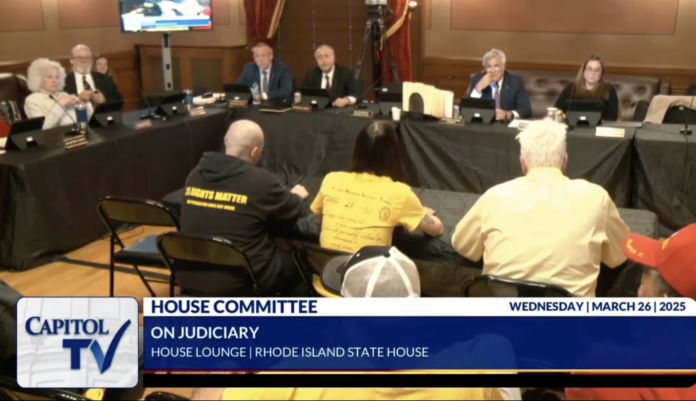PROVIDENCE – Both Meredyth Whitty, the Rhode Island Legislative Press and Public Information director, and Rep. Jason Knight, a Democrat representing District 67 in Barrington and Warren, responded to a recent NRI NOW article regarding Glocester’s opposition to a proposed ban on assault rifles.
The Town Council voted unanimously to oppose the bill, which Council President William Worthy described as banning not just assault weapons, but practically every firearm, from antique side block rifles, to anything that could have a magazine altered to hold more than 10 rounds. Both Knight and Whitty, however, say this is not exactly the case.
“I think there’s a lot of misinformation floating around about this bill,” Knight told NRI NOW. “The bill is pretty specific. There’s a lot of information out there which tends to mischaracterize what is actually in the bill.”
To start, said Whitty, the cutline of the photo which appeared in the previous article says “an 1863 Remington side block rifle, which would be banned under a recently proposed ‘assault weapons’ bill,” would certainly not be banned, which can be seen by reading the bill – although she admitted, it’s some pretty complicated reading.
Furthermore, she continued, this is not something that has to be written into this particular bill, since antique weapons are exempt from the entirety of our state’s gun laws, as stated in Title 11, Chapter 47. That exemption uses the federal definition, which is all firearms from before 1898. This bill, she said, would be part of that chapter if adopted and the gun would never be subject to the new law if enacted.
“The idea that it would be banned under the bill is not accurate,” agreed Knight.
Whitty pointed to the definition of assault weapons in the bill, located on page 1, number 2.
“All the categories of assault weapons are numbered with the lowercase Roman numerals,” noted Whitty. “Every single one of them, with the exception of the second one – ii – and a couple at the end that refer to parts that can be assembled into the categories listed above, starts with ‘semi-automatic.’ Obviously, that gun is not semi-automatic. That technology had not yet been invented in 1863. And that section ii is shotguns with a revolving cylinder. It’s not that either. It would not be an assault weapon.”
“Going back to those lowercase Roman numerals, and this is the rub: A bunch of the claims Will Worthy makes about characteristics of a gun that would make it subject to this bill are secondary characteristics that would make the gun subject only if it fits in the category of the Roman numeral that item is listed under,” Whitty added.
In the example of a 1850 gun with a bayonet attached, Whitty points to the only reference in the bill to a bayonet:
(iv) A semi-automatic rifle that has the ability to accept a detachable magazine, or that may be readily modified to accept a detachable magazine, and has at least one of the following features:
(A) A folding, telescoping, or detachable stock;
(B) A bayonet mount;
So, she said, a bayonet mount would make the gun an assault weapon only if it were also a semi-automatic rifle and it can accept a detachable magazine, or can be readily modified to do so.

Whitty added that Worthy said the same thing with the “over 50 ounces” handguns and “any kind of shotgun that has a threaded barrel on it,” pointing to the bill’s only reference to 50 ounces, and one of the two references to threaded barrels:
(vi) A semi-automatic pistol that has an ability to accept a detachable magazine, or that may be readily modified to accept a detachable magazine, and has at least one of the following:
(A) The capacity to accept an ammunition magazine at a location outside of the pistol grip;
(B) A threaded barrel capable of accepting a barrel extender, flash suppressor, forward handgrip, or silencer;
(C) A shroud that is attached to, or partially or completely encircles, the barrel and that permits the shooter to hold the firearm with the non-trigger hand without being burned but excluding a slide that encloses the barrel;
(D) A manufactured weight of fifty ounces (50 oz.) or more when the pistol is unloaded;
“So weighing 50 ounces makes a gun an assault weapon only if the gun is a semi-automatic pistol that can have a detachable magazine or be altered to accept one,” said Whitty. “A threaded barrel makes something an assault weapon only if it’s also a semi-automatic pistol with that capability for a detachable magazine or if it’s also a semi-automatic rifle with detachable magazine capability.”
Here’s that section:
(iv) A semi-automatic rifle that has the ability to accept a detachable magazine, or that may be readily modified to accept a detachable magazine, and has at least one of the following features:
(A) A folding, telescoping, or detachable stock;
(B) A bayonet mount;
(C) A grenade launcher;
(D) A shroud attached to the barrel or that partially or completely encircles the barrel, allowing the bearer to hold the firearm with the non-trigger hand without being burned, except an extension of the stock along the bottom of the barrel, which does not encircle or substantially encircle the barrel.
(E) A pistol grip or thumbhole stock; or
(F) A flash suppressor or threaded barrel designed to accommodate a flash suppressor;
“I totally understand that the bill’s definition of ‘assault weapon’ is really complicated,” Whitty said. “But it has to be this specific in order not to apply to a bunch of firearms that aren’t the high-powered weapons it’s intended to prohibit, and people who like guns should appreciate its specificity.”
“This bill makes me glad I paid attention in 6th grade when my teacher taught us how to use numbered outlines with uppercase and lowercase Roman numerals, letters and numbers,” she added. “I understand that it’s confusing, but I would have been happy to answer any questions or find someone who could if I could not.”
“Amongst some communities, the contents of the bill have turned into a giant game of telephone where one person tells another person who tells another person and people get the wrong idea about what’s in the bill,” Knight said. “If they read it, they would get the right idea.”
As far as registering weapons, Knight said they were in the process of eliminating that from the proposed bill.
“We’re intent on removing that,” he said.
Knight said it was unclear yet when the bill would be voted on. When the vote does come, however, he is certain the bill will pass.
“A huge margin of Rhode Islanders support this kind of law,” added Knight.
Polls, both recent and older, show that support, he said. The older poll showed three out of four Rhode Islanders were in favor of it. When the ban on high capacity magazines was passed, there were no repercussions as far as the election was concerned.
“I recognize that with this bill, there are some people who don’t want to see it; they disagree with the policy behind it,” Knight said. “But I think most Rhode Islanders agree with the policy of removing assault weapons. They think it enhances gun safety, and that’s where I am focusing my efforts.”
The legislation was introduced in the House on February 12, and is currently pending in the House Judiciary Committee









Another “feel good”bill promoted by virtue signaling people who have no true knowledge of firearms or respect for the Second Amendment.
This bill will do NOTHING to prevent crime or punish criminals but it will infringe on the rights of law abiding citizens. Liberals will not be satisfied until all firearms are confiscated from honest citizens and criminals will have free reign.